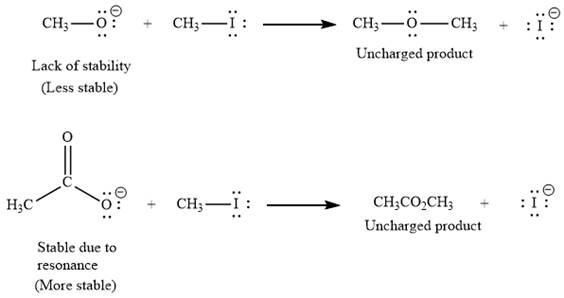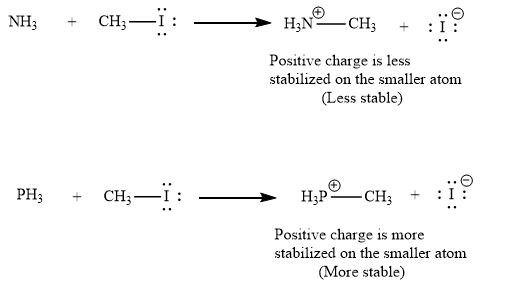
(a)
Interpretation:
It is to be predicted which of the two nucleophiles in the given pair will react faster with
Concept introduction:
The minimum amount of energy required by reacting molecules to reach the transition state is called the activation energy.
For nucleophilic substitution reactions, if the reactant is the same, the activation energy increases with increasing stability of the substitution product.
The reaction is faster when the energy barrier between the reactants and products is small. When energy difference between reactants and the transition state is smaller than the energy difference between products and transition state, the reactants are highly reactive and reaction is faster. Highly reactive reactant molecules serve as strong nucleophiles. The reactants are less reactive and the reaction slower, when the transition state is closer in energy to the products than the reactants.
Answer to Problem 9.4P
(i) Among the two nucleophiles, the nucleophile
(ii) Among the two nucleophiles, the nucleophile
Explanation of Solution
(i) The first given pair of nucleophiles is
The reactions of each of these nucleophiles with

There is a significant difference in charge stability on the reactant side but not on the product side because the negative charge in
(ii) The second given pair of nucleophiles is
The reactions of each of these nucleophiles with

There is a significant difference in charge stability on the product side but not on the reactant side. Because a positive charge is more stable on phosphorous atom than on nitrogen atom, the product of the nucleophilic substitution involving
Therefore, the energy barrier involving
As nucleophilicity of the attacking species increases in
(b)
Interpretation:
It is to be determined which of the given pairs is the stronger nucleophile.
Concept introduction:
The minimum amount of energy required by reacting molecules to reach the transition state is called the activation energy. For nucleophilic substitution reactions, if the reactant is the same, the activation energy increases with increasing stability of the substitution product. When energy difference between reactants and the transition state is smaller than the energy difference between products and transition state, the reactants are highly reactive and reaction is faster. Highly reactive reactant molecules serves as strong nucleophiles.
Answer to Problem 9.4P
(i) Among the pair of nucleophiles,
(ii) Among the two nucleophiles,
Explanation of Solution
(i) The first given pair of nucleophiles is
In part (a), it is determined that the reaction of
(ii) The first given pair of nucleophiles is
In part (a), it is determined that the reaction of
Among the two given nucleophiles, the stronger nucleophile is the one that exhibits a faster reaction.
Want to see more full solutions like this?
Chapter 9 Solutions
Organic Chemistry: Principles And Mechanisms
- Experiment 27 hates & Mechanisms of Reations Method I visual Clock Reaction A. Concentration effects on reaction Rates Iodine Run [I] mol/L [S₂082] | Time mo/L (SCC) 0.04 54.7 Log 1/ Time Temp Log [ ] 13,20] (time) / [I] 199 20.06 23.0 30.04 0.04 0.04 80.0 22.8 45 40.02 0.04 79.0 21.6 50.08 0.03 51.0 22.4 60-080-02 95.0 23.4 7 0.08 0-01 1970 23.4 8 0.08 0.04 16.1 22.6arrow_forward(15 pts) Consider the molecule B2H6. Generate a molecular orbital diagram but this time using a different approach that draws on your knowledge and ability to put concepts together. First use VSEPR or some other method to make sure you know the ground state structure of the molecule. Next, generate an MO diagram for BH2. Sketch the highest occupied and lowest unoccupied MOs of the BH2 fragment. These are called frontier orbitals. Now use these frontier orbitals as your basis set for producing LGO's for B2H6. Since the BH2 frontier orbitals become the LGOS, you will have to think about what is in the middle of the molecule and treat its basis as well. Do you arrive at the same qualitative MO diagram as is discussed in the book? Sketch the new highest occupied and lowest unoccupied MOs for the molecule (B2H6).arrow_forwardQ8: Propose an efficient synthesis of cyclopentene from cyclopentane.arrow_forward
- Q7: Use compound A-D, design two different ways to synthesize E. Which way is preferred? Please explain. CH3I ONa NaOCH 3 A B C D E OCH3arrow_forwardPredict major product(s) for the following reactions. Note the mechanism(s) of the reactions (SN1, E1, SN2 or E2).arrow_forward(10 pts) The density of metallic copper is 8.92 g cm³. The structure of this metal is cubic close-packed. What is the atomic radius of copper in copper metal?arrow_forward
- Predict major product(s) for the following reactions. Note the mechanism(s) of the reactions (SN1, E1, SN2 or E2).arrow_forwardPredict major product(s) for the following reactions. Note the mechanism(s) of the reactions (SN1, E1, SN2 or E2).arrow_forwardQ3: Rank the following compounds in increasing reactivity of E1 and E2 eliminations, respectively. Br ca. go do A CI CI B C CI Darrow_forward
- Q5: Predict major product(s) for the following reactions. Note the mechanism(s) of the reactions (SN1, E1, SN2 or E2). H₂O דיי "Br KN3 CH3CH2OH NaNH2 NH3 Page 3 of 6 Chem 0310 Organic Chemistry 1 HW Problem Sets CI Br excess NaOCH 3 CH3OH Br KOC(CH3)3 DuckDuckGarrow_forwardQ4: Circle the substrate that gives a single alkene product in a E2 elimination. CI CI Br Brarrow_forwardPlease calculate the chemical shift of each protonsarrow_forward
 Organic Chemistry: A Guided InquiryChemistryISBN:9780618974122Author:Andrei StraumanisPublisher:Cengage Learning
Organic Chemistry: A Guided InquiryChemistryISBN:9780618974122Author:Andrei StraumanisPublisher:Cengage Learning
